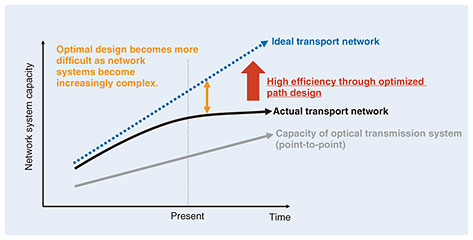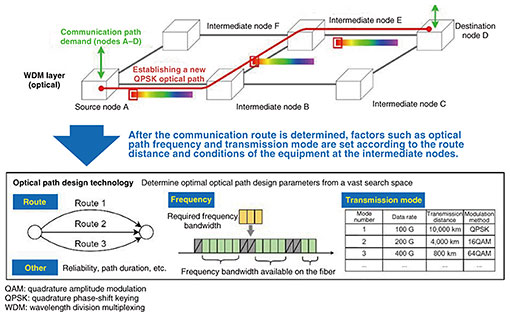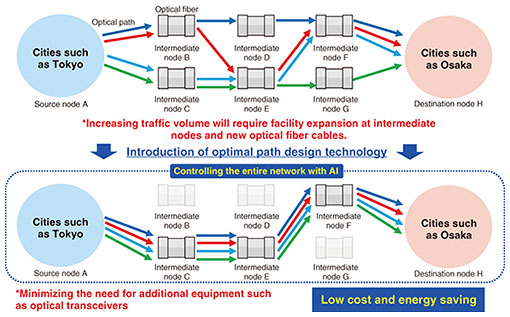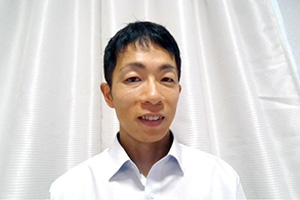 |
|
|
|
|
|
Rising Researchers Vol. 23, No. 11, pp. 14–20, Nov. 2025. https://doi.org/10.53829/ntr202511ri1  Highly Efficient, Low-cost Optical Communications through Optimal Communication Path Design TechnologyAbstractThe Internet services we take for granted every day are supported by optical communication technology, which enables long-distance, high-capacity communications, and many pieces of equipment, including optical fiber cables and optical transceivers. However, many challenges remain, such as the increasing complexity of optical network design as optical communication technology evolves and the need to address the cost savings associated with the ever-increasing amount of communication equipment. Even under these circumstances, using design technology for configuring optimal communication paths will make it possible to support more communication traffic economically even with existing communication equipment and facilities. We spoke with Takafumi Tanaka, a distinguished researcher at NTT Network Innovation Laboratories and a leader in optimal communication path design technology. Keywords: transport network, communication path design, reinforcement learnings Innovative AI-based optimal communication path design technology maximizes transport network efficiency—Would you tell us what prompted you to start this research and the background on the demand for this technology? If we think of the term “transport network” from a hardware perspective, we think of the current Internet environment, namely, a communication network that uses optical fiber cables laid across the world to store, send, and receive various types of communication information via long-distance, high-capacity optical communication technology. When I joined NTT, the world of optical communications was in a period when digital coherent communication, which exploits the wave properties of light, was just about to be commercialized. Since then, many innovative technologies, such as space division multiplexing (which enables multiple optical communications to coexist on the spatial axis of a single optical fiber), have been developed, and efforts to use these technologies have made it possible to transport large volumes of information and data over greater distances economically. From a network perspective, however, this situation means that “paths” (communication routes with varying capacities) connecting various locations worldwide coexist within the same optical fiber cable in terms of not only the actual route but also the frequency and spatial axes. If the paths over which communication data travel cannot be appropriately configured, communication will become saturated in a similar manner to traffic congestion on the road. If such saturation occurs, the innovative capabilities of optical fiber and optical communications will not be fully used. Only by technologically expanding the capacity and distance of optical communications and effectively using both can an efficient and economical transport network be established (see Fig. 1).
Since joining NTT, I have been conducting research and development on topics such as (i) the way to configure the transport network, (ii) design technology that determines the routes and frequencies, and modulation methods used for the communication paths set up within the network, and (iii) control technology that sends commands to optical transceivers and intermediate devices to set up communication paths and change routes. If we compare the above-described “transport network design and control technologies” to a highway system, in which the roads represent communication channels and each traveling car represent communication data, we can imagine these technologies as a navigation system for the online world. For example, if one wants to drive from Tokyo to Osaka, it might be quicker to use the Tomei Expressway or the Chuo Expressway given the current traffic conditions or it may be quicker to take the Shin-Tomei Expressway near Shizuoka even though congestion is expected. These transport network design and control technologies can be thought of as the result of research and development of a navigation program for optical communications using artificial intelligence (AI) to make optimal decisions. —How do you approach technological research? Would you give us specific examples? To give a specific example of our achievements, one type of transport network is a multi-layer network in which a large number of digital paths with lower rates are multiplexed onto a high-capacity optical path with capacity of over 100 Gbit/s. Using this multi-layer network, we have developed a design technology that simultaneously determines the optical path design parameters, namely, route, frequency, and modulation format, and the digital path route. We have demonstrated that using this design technology can double the number of digital paths that can be accommodated in the same optical fiber links compared with conventional methods. Two methods are used for designing paths for improved efficiency of transport networks: mathematical design and design using manually created rules. However, whichever method is used, it is difficult to achieve high utilization efficiency and short calculation time simultaneously. We are therefore currently developing path design technology that makes full use of AI to solve this problem. Although “path design” is a general term, the required design depends on the configuration of the target network, service type, and network operation conditions to be met. Design tasks to be executed before putting a network to actual use are, for example, equipment design—which involves estimating the minimum amount of equipment to be deployed according to the expected traffic volume of the communications service to be provided—and capacity design—which involves determining the routes and frequencies to be assigned to the network in response to demands on communication path configuration that arise during the operation of the actual communication services. Switching tasks include switching to a backup route when the planned communication path becomes unavailable (due to unforeseen factors such as an optical fiber failure) and switching an already configured path to a newly configured route or frequency for the sake of optimization. The importance of optical networking technology such as the above-described path design technology is expected to increase with the advent of 5G and 6G (fifth- and sixth-generation mobile communication systems) as well as communications between datacenters, and research on technology for optimization of path design is one way to address the expected shortage of optical fiber capacity. I am researching technology that applies a type of AI called “reinforcement learning,” with which computers try to find better solutions through trial and error, to the various path design problems that I mentioned previously. My research has confirmed that compared with conventional methods for solving various path design problems, reinforcement learning can double the number of digital paths that can be accommodated in the same optical fiber links, as described above. By using reinforcement learning, we aim to increase efficiency by more than three times (Fig. 2).
—What difficulties did you face in your research and what challenges do you see in future research? Path design involves selection of many variables, such as communication channel, frequency, and modulation method (transmission modes) (Fig. 3), and optimizing these simultaneously and instantaneously is not easy, even by using reinforcement learning by AI. Originally, as a branch of machine learning (a method used by AI), reinforcement learning aimed to improve performance by using large amounts of data; however, it faced drawbacks such as the long time required of the learning process and the difficulty in obtaining good results regardless of the amount of learning if the parameters are not set properly. Optical paths are subject to constraints specific to optical communications, namely, the requirement that the frequency used between nodes must be constant and the fact that the width of the frequency bandwidth occupied by each optical path varies. In addition, the data and computing resources required for learning increase in proportion to the scale of the network (intra region, intra country, inter country, etc.), and that requirement makes it even more difficult to optimize models by using reinforcement learning. Research and development on AI is progressing rapidly, and we can expect that all calculations will be completed by AI in the future. However, at this stage, I believe that rather than applying AI to the whole process for setting optical path parameters, we should think about how to combine AI-based methods with traditional, proven heuristic methods.
I am neither a specialist in optical transmission nor a specialist in machine learning. I therefore struggled to determine how to combine these fields and use them in network design. While referencing books and papers is useful, technological trends change very quickly, so the best way to obtain and respond to the latest trends and useful implementation techniques is to acquire firsthand information from experts in the field. In that sense, NTT has a team of professionals in every field related to communications, and being able to learn the latest information from them is a truly great advantage. Aiming for more efficient, autonomous transport network operations and labor savings—Would you tell us about the prospects for your research and how you plan to use the results of that research in regard to the IOWN initiative? If our optimal optical path design technology is put into practical use, it will be possible to reduce the need for new (and costly) optical fiber cables and the amount of additional equipment, such as optical transceivers, in a manner that leads to an economical transport network. It will also enable more efficient and effective use of existing equipment in a manner that reduces power consumption. In particular, optical transceivers consume much more power as the amount of data they process increases, so it is considered that technology that effectively uses optical communication resources will become increasingly important. In light of this technological background, the medium-term outlook is to use our technology as a way to increase efficiency concerning various aspects of network operation. Current estimates suggest that if this design technology is used, it should be possible to reduce power consumption by around 30%. Optical communication technology is being actively introduced into datacenters as a solution to the increasing power consumption that accompanies the present-day, ever-increasing communication capacity. Even if communication traffic volume increases dramatically, the operation and maintenance work required to use the transport network as a communication infrastructure will continue to be essential in terms of maintaining NTT’s basic capability as a communication carrier, which is to provide communication services with high reliability continuously. Various practical issues beyond research, such as responding to future increases in communication volume, labor shortages, aging of the personnel involved in operations and maintenance, and technology transfer, need to be addressed. With those issues in mind, in the long term, we aim to use AI to automate and autonomize all network operation systems, including those for monitoring, fault detection, and recovery. It should thus be possible to not only reduce the cost of newly installed equipment such as the above-mentioned optical fiber cables and optical transceivers but also reduce costs (such as power consumption) and labor (such as labor costs for operation) for the entire transport network (Fig. 4).
The Innovative Optical and Wireless Network (IOWN)—an initiative being promoted by NTT—demands the provision of end-to-end transmission with low power consumption, high capacity, and low latency. Providing that capability to a large number of end users over an actual transport network will likely necessitate more than just installing or adding optical fiber cables and optical transceivers. In addition to the utilization of technologies such as multiplexing on the frequency and spatial axes of optical paths, the way transport networks are used in the future is likely to change. I anticipate that this combination of technologies will result in a “time-sharing path usage method,” with which various users will be able to reserve optical path, occupy the line only during the times they wish to use it, release the line when their communication is complete, and let the next user use the same optical path. In other words, network usage will change to even more dynamic forms than before. If this type of optical path usage becomes common, optical paths will be set up and released frequently in a manner that could lead to a situation in which utilization efficiency of optical fiber resources decreases. I believe that in such an environment, the optimal optical path design technology that I have been researching will play an important role. —Would you tell us how you came to join NTT? In graduate school, I researched communication protocols and video distribution methods using them. In fact, I only started using a personal computer after entering university, but I found the world of the Internet to be fascinating. At that time, the spread of broadband had led to the emergence of video and various online services, and I felt that such Internet services had great potential for the future. The reason I applied to NTT was twofold: first, I have always been interested in how new value and services are created when things are connected to one another and, second, I wanted to work in a field that would enrich the lives of as many people as possible. When I joined NTT, mobile phones were evolving from feature phones to smartphones, the value of information and communications was gaining attention, and many people were beginning to use smartphones. It was also a time when signs of today’s Internet society were becoming apparent. Since then, I have been involved in research and development of transport networks, namely, the foundation of many communication services. The research institute of which I am a member, NTT Network Innovation Laboratories (NIL), is currently researching themes across a variety of fields and using high-capacity communications technology to create services and a society that were previously impossible. One of its greatest features is the coexistence of research and development in vastly different fields and phases ranging from wireless to optical and from research on fundamental technologies to technological development near commercial adoption. I believe that having such a wide range of research content undertaken within the same research institute can be a source of innovative technology; in fact, many of my research themes have produced technologies and results that would not have been possible without collaboration with researchers from different departments, so I feel that I am one of the people who has benefited from this situation. —What is your impression of NIL, where you work? Although I currently work mostly remotely, we have tools in place that enable employees to communicate with each other even when working remotely, and we can work with almost the same efficiency as if we were working in the office. Of course, when necessary, I also come into the office to discuss things face-to-face with team members or conduct experiments and verifications in the laboratory. I think a major attraction of NIL is that we can choose the research environment that best suits our individual lifestyles and research phases. What’s more, I also think NIL is among the best in Japan in terms of its hospitality in creating a comfortable research environment, providing ease of working. Moreover, regardless of one being in Japan or overseas, simply mentioning NTT has such name value that people can trust us. This status is due to the fact that most of the information and communication technology services we use every day involve research and development done by NTT in some way or another, and the ground-breaking research results that have been passed down from our predecessors have enriched our lives and built trust. As for current NTT researchers like me, with such a long history, NIL is a place where we are proud to work; at the same time, it inspires us to produce results that will leave a lasting legacy in the same manner as our predecessors. —What is your message to researchers, students, and business partners? NTT has a long history and tradition of accumulating the fruits of research and technological development. Indeed, it could be described as a “fountain of knowledge.” I believe that the mission entrusted to us as the next generation is to use this fountain of knowledge as a starting point to produce further research results that lead to the creation of the next generation of communication infrastructure, innovative technologies, and services. We at NIL welcome senior researchers with proven research achievements, business partners with social knowledge and experience, and motivated students who are intrigued by the unique strengths of NTT laboratories—even if they lack experience—to join forces with us and become a force for opening up a new era.
■Interviewee profileTakafumi Tanaka received an M.S. in fundamental informatics from the Graduate School of Frontier Sciences, The University of Tokyo in 2009. In the same year, he joined NTT. In 2023, he completed his doctoral course in information and communication engineering at the Graduate School of Engineering, Nagoya University and received a Ph.D. in engineering. From 2024, he became a distinguished researcher at NTT Network Innovation Laboratories, where he has been engaged in research on transport network design and control technologies. He received the IEEE ComSoc JC Young Engineer Award in 2012 and the IEICE Communications Society Outstanding Paper Award in 2022. In 2025, he became a visiting professor at Osaka University and part-time lecturer at Waseda University. |
|













